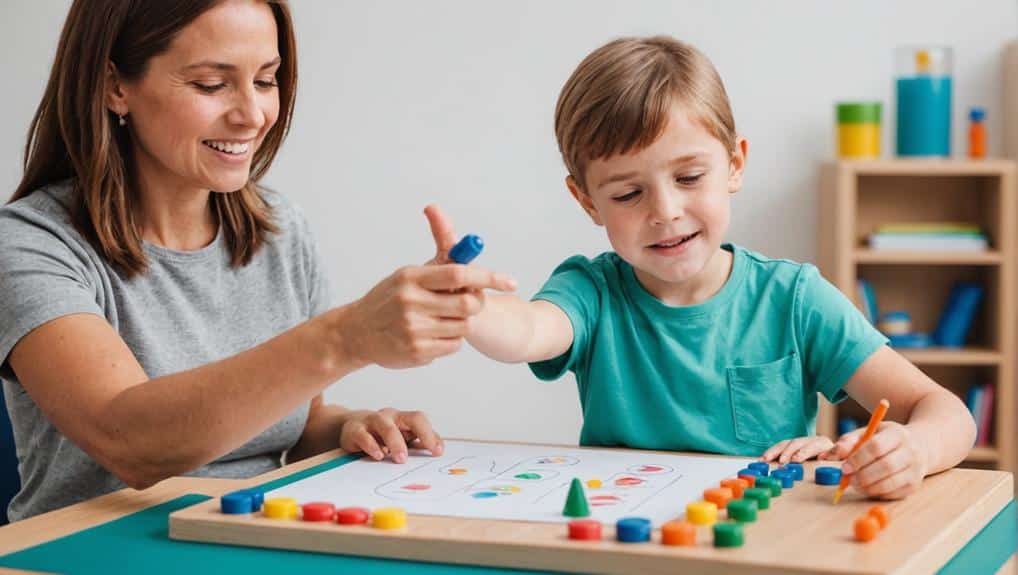The prevalence of Sensory Processing Disorder (SPD) in children and its potential impact on cognitive and physical development underscores the need for effective interventions. Pediatric Occupational Therapy (OT) is a potent tool to address this issue, employing various methodologies to improve sensory integration. While the benefits of this therapeutic approach are increasingly recognized, the specific mechanisms through which it operates and the extent of its efficacy remain subjects of ongoing research. This prompts a closer examination of how occupational therapy can help children with SPD better navigate their sensory experiences.
Key Takeaways
- Occupational therapy uses sensory integration techniques such as deep pressure and rhythmic movements to manage SPD in children.
- Sensory integration therapy includes play-based activities that help regulate sensory responses, enhancing cognitive functioning and self-control.
- Parental training is crucial for the effectiveness of therapy at home, with therapists providing guidance for creating a sensory diet.
- Evaluation of specific sensory processing difficulties is an essential initial step in occupational therapy, leading to customized treatment plans.
- Occupational therapy promotes functional behavior and independence and provides a safe space for sensory exploration.
Understanding Sensory Processing Disorder
Sensory Processing Disorder (SPD) is a complex neurological condition in which the brain struggles to receive and appropriately respond to information that comes in through the senses. Pediatric OT techniques, like sensory integration and structured task management, can enhance focus and attention span in children suffering from SPD. Children afflicted with SPD may exhibit oversensitivity or undersensitivity to sensory stimuli such as touch, sound, taste, or movement. This imbalance can significantly impact their behavior, emotions, and ability to learn and interact with their environment.
Occupational therapy plays a crucial role in managing SPD. It offers effective sensory integration techniques that help improve a child’s ability to process and respond to sensory input. By engaging in occupational therapy, children with SPD can better regulate their responses to sensory stimuli, enhancing their daily functionality.
Understanding SPD is essential for professionals who aim to serve these children. It helps tailor interventions that address specific sensory needs, fostering an environment supporting their learning and growth. With the right approach, including occupational therapy and sensory integration therapy, we can help children with SPD navigate the world around them confidently and comfortably, enhancing their quality of life.
Role of Occupational Therapy in SPD
Occupational therapy emerges as a core component in the treatment of Sensory Processing Disorder. It aims to foster automatic responses to sensory stimuli and improve functional behavior. Occupational therapists address sensory integration difficulties through tailored treatment strategies, ensuring every child receives the attention and care needed to boost their social participation and overall quality of life.
In line with sensory integration techniques, occupational therapists employ deep pressure techniques and rhythmic movements to provide calming input and improve focus. They also expose children to different textures to encourage sensory exploration, effectively managing sensory-seeking behaviors.
The occupational therapy for sensory approach typically involves:
- Thorough assessments to understand the child’s distinct sensory profile and functional challenges.
- Personalized treatment plans include sensory integration therapy, which uses specific sensory activities like swinging, bouncing, spinning, and brushing.
- Monitoring and adjusting treatment strategies based on the child’s progress and evolving needs.
Treating Sensory Processing Disorder through occupational therapy has been reported to increase concentration, decrease anxiety levels, and improve overall sensory processing in children. As professionals committed to serving others, occupational therapists play a significant role in enabling children with SPD to navigate their sensory world more effectively. Through their skillful intervention, they foster a sense of normalcy and control in the lives of these children, leading to boosted self-esteem and improved life outcomes.
The Concept of Sensory Integration

Sensory integration, a fundamental concept in occupational therapy, plays a pivotal role. Sensory integration refers to the brain’s ability to organize and interpret sensory information from the environment and within the body. This mechanism is essential for interacting with the world, enabling us to respond appropriately to sensory stimuli.
As part of a larger ADHD management strategy, occupational therapists also utilize sensory processing strategies to address specific sensory needs. This includes implementing sensory diets, which help regulate sensory experiences and improve focus.
Occupational therapy focuses on improving sensory integration, particularly in children with Sensory Processing Disorder (SPD). These children often struggle with interpreting sensory input, impacting their daily functioning, from simple tasks like dressing to complex ones like social interaction. Therefore, occupational therapists employ targeted interventions to address these challenges.
The ultimate goal of occupational therapy for children with SPD is to boost their sensory integration, aiding them to regulate their responses to sensory stimuli. By doing so, these children can enhance the skills and abilities necessary for daily living. It’s important to note that while occupational therapy can significantly assist children with SPD, each child is distinct, and the approach must be tailored to meet their specific needs and strengths. This compassionate, patient-focused approach is fundamental to the practice of occupational therapy.
Sensory Integration Therapy Explained
An estimated large amount of children with Sensory Processing Disorder (SPD) greatly benefit from a specific approach known as sensory integration therapy. Administered by occupational therapists, this therapy involves specific sensory activities to regulate sensory responses and develop automatic responses to sensations.
These activities match each child’s sensory preferences, enriching cognitive functioning and self-control by incorporating individually crafted sensory integration strategies. The therapy also includes play-based activities that foster improved attention span and self-regulation, which are crucial for managing stimuli responses.
Sensory integration therapy is characterized by:
- Incorporating play-based activities to improve social participation and engagement
- Creating personalized treatment plans
- Setting relevant, achievable goals for each child
These elements are essential in enriching a child’s overall well-being with SPD.
Occupational therapists play a crucial role in this process. Their expertise in understanding and addressing sensory processing difficulties enables them to create strategies tailored to each child’s needs and capabilities. This tailored approach makes sensory integration therapy one of the most effective treatment methods for children with SPD.
Reported outcomes of sensory integration therapy include increased concentration, decreased anxiety levels, and improved sensory processing abilities. These improvements can significantly boost the quality of life for children with SPD, supporting them in engaging more effectively in their daily activities. The role of occupational therapy in sensory integration therapy cannot be overstated, and its impact on children with SPD is profound.
Importance of Parental Involvement

Parental engagement is a critical element of effective occupational therapy for children with Sensory Processing Disorder (SPD). It’s essential because children with SPD may also display symptoms of ADHD, such as trouble concentrating, impulsiveness, and sensitivity to feelings. By receiving adequate guidance from occupational therapists, parents can guarantee consistent and ongoing care for their child at home, reinforcing the therapeutic approaches. Moreover, parents play a vital role in establishing a sensory-supportive setting and incorporating a sensory meal plan, which can significantly boost the efficiency of the therapy.
Enhancing Home Therapies
The pivotal role of parental involvement in home therapies cannot be overstated in regards to sensory integration treatment for children with Sensory Processing Disorder (SPD). Parents can effectively facilitate home therapies by diligently following the instructions and guidelines provided by occupational therapists. This active participation from parents is akin to how routines for managing ADHD are structured, with tailoring and adaptation to meet the child’s individual needs.
This involvement is vital for several reasons:
- It helps create a consistent sensory diet tailored to meet the distinct sensory needs of the child.
- Parents’ involvement guarantees ongoing support and reinforcement, a fundamental aspect of sensory processing improvements.
- Regular home therapies provide a framework for reinforcing progress made during formal therapy sessions.
Parental Training Importance
Ensuring the effectiveness and consistency of sensory integration therapy at home relies heavily on parental coaching. It is pivotal in equipping parents with the necessary skills to continue the therapy techniques outside of the clinical setting. This home-based approach enriches the child’s progress and reinforces skills learned during therapy sessions.
Occupational therapists play an essential role in providing parental coaching. They educate parents on creating a sensory diet—a structured routine that provides sensory input for their child, promoting regulation and balance. This sensory diet, tailored to meet each child’s needs, can include swinging, jumping, or tactile play.
Parental involvement is the cornerstone of successful sensory integration therapy. By implementing the learned strategies and techniques at home, parents essentially become an extension of the therapy team. This collaborative approach fosters a supportive environment that encourages the child’s development and progress. Hence, parental coaching is not merely an add-on but an integral part of sensory integration therapy, highlighting the significance of their role in the treatment process.
Evaluation Process for Sensory Issues
Evaluating sensory issues in children with Sensory Processing Disorder (SPD) is a crucial initial step in occupational therapy. Therapists can identify specific sensory processing difficulties by carefully observing a child’s responses to stimuli and detailed developmental history assessments. This fundamental early evaluation enables the development of a customized treatment plan and provides a baseline for measuring the progress and effectiveness of subsequent therapeutic interventions.
Assessing Sensory Challenges
In occupational therapy, a detailed sensory evaluation is crucial to pinpointing specific hurdles in a child’s sensory processing. Occupational therapists observe a child’s reactions to different stimuli in varied settings, noting behavior, responses, and any indicators of discomfort or unease. This enables them to identify areas of potential struggle in sensory processing.
Key components in this procedure include:
- The careful observation of autonomic functions like heart rate and breathing. These involuntary reactions can offer valuable insights into sensory processing challenges.
- Gathering a detailed history to comprehend the child’s developmental path assists in recognizing possible triggers for sensory issues.
- It is developing a thorough understanding of the child’s sensory obstacles. This is fundamental for customizing effective intervention strategies.
Sensory evaluations are a priceless tool for occupational therapists who strive to assist others by offering tailored, efficient strategies to help children overcome their sensory processing obstacles. The aim of these evaluations is not only to recognize the difficulties but also to enable the child to function at their best in their everyday lives. The process is done with compassion, expertise, and a profound grasp of the child’s requirements.
Importance of Early Evaluation
Early detection of sensory issues, a pivotal foundation in occupational therapy, allows for identifying specific sensory processing difficulties in children. Assessments are essential in this process, providing a baseline to track progress and measure the effectiveness of therapy. By understanding a child’s sensory issues early on, better outcomes and more effective interventions can be implemented.
Assessments involve a detailed process, including observing responses to stimuli, taking a comprehensive developmental history, and identifying areas of difficulty in sensory processing. This information is fundamental as it provides a clear picture of the child’s sensory experiences, strengths, and challenges. By doing so, occupational therapists can tailor treatment plans to address these sensory processing issues effectively.
The significance of early evaluation cannot be emphasized enough. It marks the beginning of a child’s path to improved sensory integration and underpins occupational therapy’s success. With an empathetic approach and a commitment to serving the needs of every child, early assessments are the initial step towards managing sensory issues and enhancing a child’s ability to engage meaningfully with the world around them.
Insight Into the Seven (Or Eight) Senses

Peeling back the layers of personal perception, we uncover a fascinating range of senses extending beyond the traditional five. Pioneers A. Jean Ayres and Lucy Jane Miller enriched our understanding by identifying internal senses essential for sensory integration, such as body awareness, movement, and interoception. These senses assist the brain in integrating sensory information from both inside and outside the body.
Occupational therapists working with children facing sensory integration challenges recognize that these senses are not just abstract concepts but vital components of a child’s daily life. Impairments in sensory processing can lead to:
- Difficulties in concentration and learning
- Emotional and behavioral variations
- Challenges in coordination and physical activities
Our goal in therapy is to improve sensory integration by understanding and balancing these sensory inputs. Specialized techniques like swinging, spinning, and brushing provide and regulate sensory input. This inclusive approach helps children with sensory issues to better navigate the world around them, promoting their overall well-being and leading them toward a more fulfilling life.
Techniques for Balancing Sensory Input
Understanding and managing the multiple facets of sensory perception in children with sensory processing disorders requires the application of diverse methods. Sensory integration therapy, a fundamental aspect of occupational therapy, is particularly effective at balancing sensory input for these children.
Therapists use methods such as swinging, spinning, and brushing to provide regulated sensory input to calm sensory defensiveness and fulfill sensory cravings. This treatment typically occurs within a sensory gym, a specialized setting equipped with custom equipment to address each child’s sensory processing issues.
What sets sensory integration therapy apart is its individualized approach. No two children with sensory processing disorders exhibit the same symptoms; therefore, therapy is not a one-size-fits-all solution. Instead, it’s tailored, considering the child’s distinct sensory needs and challenges.
The ultimate objective of these methods is to improve the child’s comfort and regulation in their daily activities. By assisting children inappropriately handling sensory input, they are better prepared to manage everyday sensory stimuli, promoting enhanced function and independence.
Benefits of Occupational Therapy for SPD

Occupational therapy (OT), a cornerstone in managing Sensory Processing Disorder (SPD), offers a host of benefits for affected children. The core strength of this approach lies in its tailored treatment plans, developed by expert therapists to address specific sensory processing difficulties. These plans incorporate sensory integration techniques through engaging, play-based activities, fostering skill acquisition, enjoyment, and fulfillment.
The benefits of occupational therapy for SPD are manifold:
- It promotes functional behavior and independence: Occupational therapy aids children in developing, recovering, and improving the skills necessary for daily life. The goal is to make the child as independent as possible, enhancing their comprehensive well-being.
- It offers parent involvement: Therapists educate parents on replicating therapy conditions at home, creating a supportive, familiar environment conducive to progress.
- It creates a safe space for sensory exploration: The therapy space is a haven where children can investigate and understand their sensory preferences and challenges.
Sensory Issues and Autism Connection
Exploring the intricacies of sensory sensitivities is often a reality for children diagnosed with autism spectrum disorder. These children may exhibit hypersensitivity to stimuli, including lights, sounds, tastes, and touches. The American Psychiatric Association recognizes such sensory issues as symptoms of autism, and they can significantly impact daily functioning and social interactions.
However, it is crucial to understand that not all children with sensory processing issues have an autism diagnosis. The connection between sensory issues and autism is complex, contributing to the distinct experiences and challenges of each child. Sensory processing difficulties are a common feature in autism, but they also exist independently, underscoring the necessity for personalized and thorough evaluations.
Occupational therapy plays a crucial role in addressing these intricacies. Trained professionals work with children to enhance their sensory integration, helping them navigate their environment more comfortably and effectively. Through tailored strategies and interventions, occupational therapy aims to lessen the impact of sensory issues on a child’s life, fostering their ability to engage and thrive. In autism, it is a vital resource, enhancing the child’s capacity to manage sensory sensitivities and improve their overall quality of life.
Identifying Sensory Issues in Children

Identifying sensory issues in children is crucial in providing them with the appropriate help. Symptoms often manifest as behavioral difficulties or developmental delays. Early detection can markedly improve treatment outcomes and positively impact the child’s ability to interact with their environment. Consultation with an occupational therapist skilled in spotting and managing sensory processing disorders plays a pivotal role in this process.
Recognizing SPD Symptoms
Exploring the intricate world of child development, one may encounter various sensory issues indicating a potential Sensory Processing Disorder (SPD). Recognizing these symptoms can be the initial step towards helping children navigate their sensory experiences more effectively, a primary aim of occupational therapy.
SPD may manifest in several ways, including:
- Sensitivity to lights, sounds, tastes, and touches
- An overreaction to sensory stimulation or a preference for rough play
- Challenges with eating, resistance to cuddling, or delayed motor skills.
Children with SPD may also exhibit signs of difficulty focusing, excessive movement, and environmental overwhelm. These symptoms could indicate a struggle to correctly process sensory information, which impacts their daily lives and social interactions. Treating Sensory Processing Disorders often involves a multidisciplinary approach, with occupational therapy playing a significant role.
Each child’s sensory profile is distinct; one symptom does not necessarily indicate a disorder. Nevertheless, if you notice a consistent pattern of these symptoms, consult a medical professional for an evaluation. Recognizing and addressing SPD symptoms early can significantly enhance a child’s quality of life.
Importance of Early Detection
Understanding Sensory Processing Disorder’s myriad symptoms is an essential initial step. Early detection of these symptoms can pave the way for the intervention of necessary measures, ideally leading to better child development outcomes.
The signs of sensory processing disorder may be subtle or glaringly obvious. They could include trouble focusing, excessive movement, and an overwhelming response to environmental stimuli. Other symptoms may not be as readily associated with sensory issues, such as eating problems, resistance to cuddling, delayed motor skills, or a preference for rough-housing. Overreactions to stimulation, clumsiness, or an odd posture could also indicate sensory processing difficulties.
It’s essential to remember that sensory issues can manifest differently in each child. Early detection is crucial because it allows for timely interventions, significantly improving a child’s sensory information integration. If a child shows any signs, it’s advisable to consult a medical professional for evaluation and guidance. Awareness and understanding of these signs and symptoms are crucial in serving the best interests of children dealing with Sensory Processing Disorder.
Consultation With an Occupational Therapist
When a child shows signs of sensory processing difficulties, such as exaggerated reactions to stimuli or avoidance behaviors, it can indicate that a consultation with an occupational therapist is necessary. This professional can help pinpoint specific sensory challenges affecting a child’s daily functioning.
Early identification of sensory issues through occupational therapy consultations is critical. It allows for developing tailored treatment plans that address the child’s needs. These plans can significantly enhance the child’s ability to navigate their surroundings and participate in activities that are meaningful to them.
During a consultation, the occupational therapist typically:
- Conducts thorough evaluations to identify sensory issues.
- Collects historical information and makes careful observations to grasp the child’s challenges.
- Creates a personalized treatment plan based on the assessment findings.
Occupational therapists’ roles in addressing sensory processing disorders are essential. They provide the expertise to identify sensory processing challenges early on and devise effective interventions. Their objective is to assist the child in reaching the highest level of functioning possible, thereby enhancing their quality of life.
Approaches Used in Occupational Therapy
Pediatric occupational therapy uses various approaches to assist children with sensory processing challenges. Sensory integration is a significant element of these therapeutic methods, as it promotes automatic responses to sensations and enhances social involvement. This is accomplished through a mix of play-based activities and customized sensory plans.
Play-based activities are vital in motivating children to engage with their surroundings in ways that test their sensory processing skills. These activities are crafted to be enjoyable and captivating, aiding the child’s learning and growth while subtly addressing their sensory requirements.
Sensory plans, conversely, are individualized schedules of sensory stimulation activities that aid children in processing sensory input efficiently. These plans are not related to food but encompass sensory experiences designed to meet each child’s needs.
The therapeutic objective is to enhance functional behavior and independence in children with sensory integration disorder. To guarantee progress beyond therapy sessions, occupational therapists educate parents on how to reproduce these conditions at home. By combining these methods, occupational therapy offers extensive support for children grappling with sensory processing disorders.
Occupational Therapy and Child Wellness

Occupational therapy is an essential intervention for enhancing the general wellness of a child with Sensory Processing Disorder (SPD). Given sensory integration’s crucial role in a child’s development, occupational therapists utilize their expertise to foster healthier, more balanced lives for children with SPD.
Occupational therapy targets specific challenges faced by these children, developing tailored treatment plans after thorough assessments. Therapists work diligently to stimulate automatic responses to sensory stimuli, which can significantly enhance a child’s social participation and functional behavior.
Key focuses of occupational therapy for children with SPD include:
- Sensory integration therapy involves swinging and brushing, designed to regulate sensory responses effectively.
- Detailed education for parents, helping them understand SPD and how they can create supportive environments at home.
- They are developing coping strategies for children, enabling them to navigate their daily lives with reduced sensory discomfort.
These strategies enhance sensory integration and promote overall child well-being. Occupational therapy can help children with SPD experience improved quality of life, fostering their growth into well-adjusted individuals.
Frequently Asked Questions
How Does Occupational Therapy Help With Sensory Integration Issues?
Occupational therapy aids children with sensory integration issues by implementing tailored treatment strategies. It utilizes techniques to regulate sensory responses, provides sensory diets, and educates parents on consistent home-based therapy to improve functional behavior and independence.
What Are the Occupational Therapy Interventions for Sensory Seeking?
Occupational therapy interventions for sensory-seeking behavior involve customized sensory diets with activities like swinging, bouncing, and jumping. The aim is to regulate sensory responses, improve focus, and develop coping strategies in various environments.
What Are the Interventions for Sensory Integration?
Occupational therapy interventions for sensory integration often involve sensory diets and therapeutic brushing techniques. These activities help regulate sensory responses, improve concentration, and promote social participation while reducing anxiety in children with sensory processing difficulties.
How Do You Help a Child With Sensory Integration?
Occupational therapists devise personalized programs incorporating play-based activities, sensory diets, and environmental adjustments to aid a child with sensory integration. They also instruct parents on maintaining these therapeutic conditions at home for consistent sensory management.
Conclusion
Occupational therapy enhances sensory integration in children with Sensory Processing Disorder. Children can manage their sensory challenges effectively through customized therapy plans and parental participation. Moreover, the connection between sensory issues and autism underscores the importance of early identification and intervention. Ultimately, occupational therapy promotes enhanced cognitive functioning and well-being, symbolizing a guiding light for children with SPD toward improved sensory processing.


Recent Comments